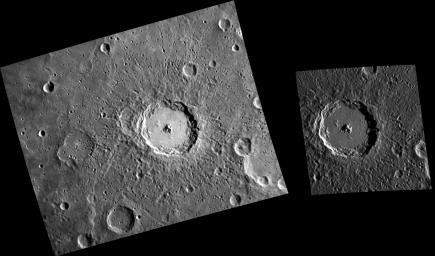Here we have two images of the impact crater named Debussy. The one on the left is from MESSENGER's monochrome base map. The one on the right is a complement from the stereo base map. Because of the differing viewing perspectives, the images can be combined to derive an elevation map (digital terrain model) of the surface.
The left image was acquired as part of MDIS's high-resolution surface morphology base map. The surface morphology base map will cover more than 90% of Mercury's surface with an average resolution of 250 meters/pixel (0.16 miles/pixel or 820 feet/pixel). Images acquired for the surface morphology base map typically have off-vertical Sun angles (i.e., high incidence angles) and visible shadows so as to reveal clearly the topographic form of geologic features. The right image was acquired as part of MDIS's high-resolution stereo base map. The stereo base map is used in combination with the surface morphology base map to create high-resolution stereo views of Mercury's surface, with an average resolution of 250 meters/pixel (0.16 miles/pixel or 820 feet/pixel) or better. During MESSENGER's one-year mission, the surface morphology base map is acquired during the first 176 days, and the second 176 days are used to acquire the complementary stereo base map, which includes the image here.
Left image:
Date acquired: July 31, 2011
Image Mission Elapsed Time (MET): 220581440
Image ID: 572963
Instrument: Narrow Angle Camera (NAC) of the Mercury Dual Imaging System (MDIS)
Center Latitude: -34.04°
Center Longitude: 11.25° E
Resolution: 284 meters/pixel
Incidence Angle: 67.2°
Emission Angle: 35.2°
Phase Angle: 102.4°
Right image:
Date acquired: January 19, 2012
Image Mission Elapsed Time (MET): 235424544
Image ID: 1283627
Instrument: Narrow Angle Camera (NAC) of the Mercury Dual Imaging System (MDIS)
Center Latitude: -33.95°
Center Longitude: 13.18° E
Resolution: 161 meters/pixel
Incidence Angle: 76.9°
Emission Angle: 23.3°
Phase Angle: 89.2°Scale: Debussy crater has a diameter of about 80 km (50 mi.)
The MESSENGER spacecraft is the first ever to orbit the planet Mercury, and the spacecraft's seven scientific instruments and radio science investigation are unraveling the history and evolution of the Solar System's innermost planet. Visit the Why Mercury? section of this website to learn more about the key science questions that the MESSENGER mission is addressing. During the one-year primary mission, MDIS is scheduled to acquire more than 75,000 images in support of MESSENGER's science goals.
These images are from MESSENGER, a NASA Discovery mission to conduct the first orbital study of the innermost planet, Mercury. For information regarding the use of images, see the MESSENGER image use policy.

 Planetary Data System
Planetary Data System












